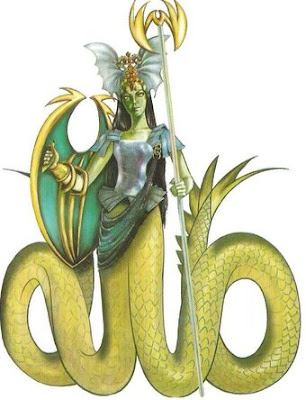So in a recent post I mused about sonic medusas: a medusa who petrifies with her voice instead of her gaze. Then I mused some more about it, and realized it was a bad idea because that’s basically a siren (the gameplay implication is the same: plug your ears). Then I thought, “wait, why should that stop me?”
I think the answer lies in the name.
Everyone knows who Medusa is, either from the original greek myth or one of its many cultural derivatives. As a culture, we share a general sense of how a monster named “Medusa” looks and behaves. The word “medusa” signifies something outside of the scope of D&D, and we bring those preconceptions with us when we sit down to play. This meta knowledge of medusa and fantasy and the real world is what allows players to fill in the gaps between DM-mediated setting information, allowing everyone at the table to take part in the same campaign setting without enormous discrepancies in perspective.
 |
| probably not who you were thinking of |
Meta knowledge informs a player’s decisionmaking, consciously or otherwise. So, the moment a player sees a petrified statue in a dungeon and says “oh, its a medusa,” all that prior information jumps to the forefront of their mind and coalesces into in-game decisions. Players who hear the word “medusa” will search for mirrors, ready blindfolds, and keep their guard up around anything vaguely snake-related, regardless of whether their character would think to do these things.
[This is similar to the troll dilemma: anyone with a modicum of experience in the genre will know about and act on a troll’s weakness to fire… even if trolls aren’t weak to fire in your campaign.]
To be clear, I don’t care about players metagaming, which is rarely as big a deal as the DM perceives it to be. What I do care about is players being blindsided by information they would never have thought to question. A sonic medusa is a betrayal to players who hoarded mirrors and blindfolds in anticipation for a traditional medusa, punishing them for using common sense in a fantasy setting.
 |
| which of these do you think of when I say "goblin"? thought so, you dirty so and so |
Without clarification, linguistic misunderstandings open rifts between what the player/DM believe is occurring, breaking the fiction. Classic Monster Manual examples include: the gorgon (who is not one of medusa’s sisters but a giant metal bull with petrifying breath) and the lamia (who is a snake-woman pretty much everywhere else and a lion-woman in D&D). The tale of Eric and the Dread Gazebo also applies.
A D&D campaign is a fragile thing, existing only in the shared consciousness of everyone at the table—It’s honestly kind of miraculous that it holds up at all. If communication breaks down, the whole thing can unravel, so proper use of terminology and names and all that boring shit is ESSENTIAL. This is why we use orcs and goblins instead of nothics and akhlut (which are fucking cool, btw, and criminally under-appreciated in fantasy). It’s why we’re chill with owlbears and laugh at octowolves. It’s why dragons are color coded.
To answer my own question: A monster by any other name is NOT the same monster. Don’t call it a medusa unless it petrifies with a gaze. Don’t call it a siren unless it charms with a song. If nothing else does what it does, make up a name, and let players build their own frameworks around it.
Orpheme
HD 4 Defense as chain Stiletto 1d6
Move 15 Int 16 Morale 8
Special petrifying song, can cast Message
A bald, scaly woman with no visible ears and boa constrictors instead of legs. Her chin slopes into the neck, which is brimming with dull orange plumage.
Her singing is irreproducible with human vocal chords, punctuated with spitting and hissing, but the song is mesmerizingly beautiful. Mammals who listen are first slowed (no save), then save vs petrification every round afterwards. She can use Message to deliver her petrifying song to a specific target, regardless of whether they are blocking their ears.
Massive inferiority complex or enormous ego, no in-between. Probably the product of some sort of curse (she seems to have once been human, and royalty no less), although she claims there are others “of her kind”. Has a python’s metabolism, requiring no more than a human child’s worth of meat every month or so.
 |
| oh, and try an akhlut on for size. they're killer whales who shapeshift into whale-sized wolves by Alector Fencer |

wow, some scary stuff here Chris.
ReplyDeleteGary
Premier Gazebos